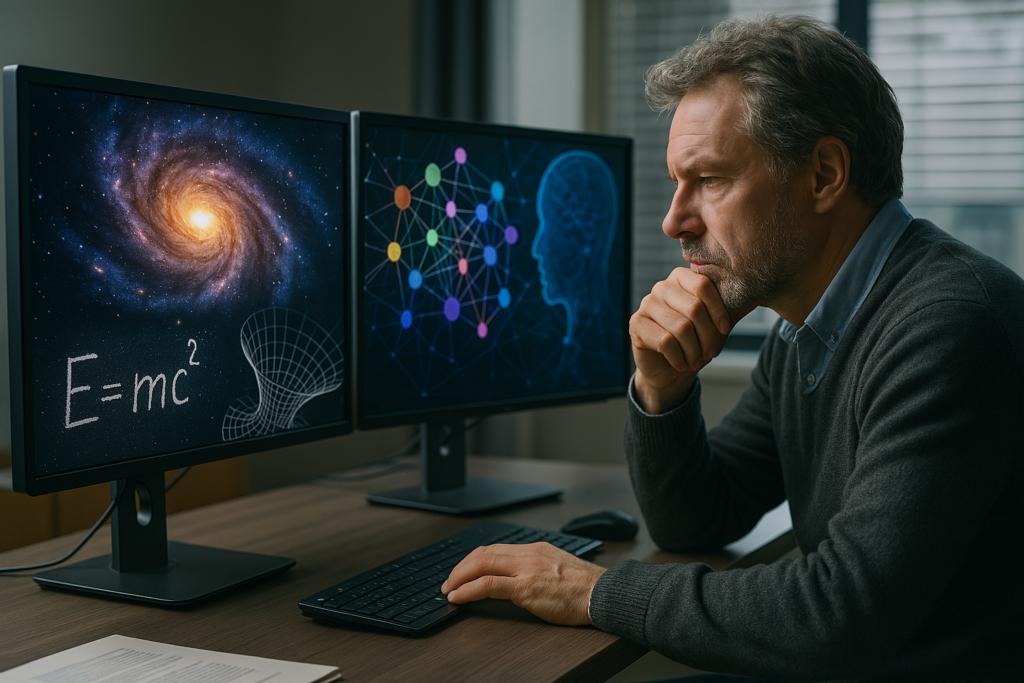Bridging the Cosmic and Computational: Integrating Physics, Deep Learning, and Eternal Consciousness
Exploring the Intersection of Universal Laws and Neural Networks to Decode the Mysteries of Existence
In the rapidly evolving landscape of scientific inquiry, a fascinating convergence is emerging between the hard-edged principles of physics and the flexible, adaptive power of deep learning. At SpeciesUniverse.com, we believe that by integrating these seemingly disparate fields, we can gain novel insights into the fundamental nature of existence—insights that may even touch upon the enigmatic realm of eternal consciousness. This post explores how the synthesis of physics and deep learning opens new vistas for understanding the universe at its deepest levels.
Physics has long been the cornerstone of our understanding of the cosmos. From Newton’s laws to Einstein’s relativity, classical theories have provided a robust framework for explaining natural phenomena. However, as our exploration extends into the more abstract and less tangible realms—such as the nature of consciousness and the structure of space-time—it becomes apparent that classical physics may not be sufficient on its own. Researchers are now rethinking old paradigms and proposing innovative theories that step outside traditional quantum confines, suggesting that there may be a “non-quantum” pathway to conceptualizing eternal consciousness.
Deep learning, on the other hand, has revolutionized the way we process and interpret complex data. Neural networks, with their capacity to learn intricate patterns from vast datasets, have demonstrated remarkable success in fields ranging from image recognition to natural language processing. The article on Towards Data Science, “Combining Physics and Deep Learning,” outlines how these algorithms can be harnessed to simulate and even predict physical phenomena by uncovering hidden patterns that might otherwise elude conventional mathematical models. This technological leap is enabling scientists to construct models that are not only predictive but also inherently adaptive.
The union of physics and deep learning represents a significant step towards a unified understanding of nature. By embedding physical laws into the architecture of neural networks, researchers are developing hybrid models that can simulate the behavior of complex systems with unprecedented precision. This synthesis is especially promising when considering theories of eternal consciousness, which propose that consciousness may emerge as a natural outcome of the universe’s self-organizing processes. In this context, deep learning provides a powerful tool for modeling how physical processes might give rise to subjective experience, offering a fresh perspective that transcends traditional dichotomies between matter and mind.
Supplementary insights from reputable institutions such as MIT and Science Magazine have bolstered this interdisciplinary approach. Cutting-edge research indicates that by applying deep learning techniques to data from cosmology and particle physics, scientists are uncovering patterns that were previously hidden in the noise of complex datasets. This integration not only validates the potential of neural networks in decoding the universe’s secrets but also paves the way for more holistic theories that encompass both objective reality and the subjective nature of consciousness. These advancements invite us to reconsider how we define and interact with the cosmos on both a macroscopic and microscopic level.
As we delve deeper into the implications of this convergence, a new understanding of consciousness emerges—one that is dynamic, adaptive, and intrinsically linked to the fundamental forces of nature. The idea of an eternal, non-quantum consciousness challenges conventional wisdom by suggesting that consciousness is not merely an emergent property of complex biological systems but a fundamental aspect of the universe itself. For thinkers like John and the community at SpeciesUniverse.com, this perspective is both humbling and exhilarating. It calls for an open-minded exploration that embraces scientific rigor while remaining receptive to the possibility that our universe is far more interconnected than previously imagined.
In conclusion, the synthesis of physics and deep learning is ushering in a transformative era in scientific thought. By leveraging the analytical power of neural networks alongside the timeless laws of physics, researchers are poised to uncover new dimensions of reality—dimensions that may hold the key to understanding not just the material world but the very essence of consciousness. As we move forward, it is imperative that we foster a dialogue between these disciplines, nurturing an integrated approach that can propel humanity toward a deeper, more nuanced understanding of its place in the cosmos.
Key Takeaways:
- Unified Perspective: Merging deep learning with classical and modern physics opens new pathways to model and understand complex phenomena, potentially bridging the gap between objective processes and subjective consciousness.
- Technological Empowerment: The integration of neural networks with physical laws allows for adaptive, data-driven models that enhance our capacity to simulate, predict, and ultimately understand the universe’s intricate behavior.
- Path to Discovery: By embracing a holistic approach that transcends traditional boundaries, we are on the cusp of revolutionary insights that may redefine the nature of existence and the eternal essence of consciousness.
“The most incomprehensible thing about the universe is that it is comprehensible.”
– Albert Einstein
Join us on SpeciesUniverse.com as we continue to explore these groundbreaking intersections of science, technology, and philosophy. Share your thoughts, dive into our related articles, and become part of the conversation that is reshaping our understanding of the cosmos. Let’s push the boundaries of knowledge together!
More details: here
References:
- Towards Data Science (Website)
- MITCBMM (YouTube Channel)


Leave a Reply